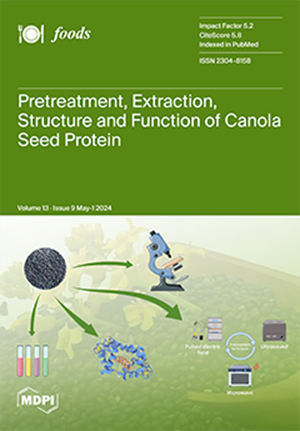南方鲶鱼(Silurus meridionalis)生食和熟食皮肤胶原蛋白的特性
IF 4.7
2区 农林科学
Q1 FOOD SCIENCE & TECHNOLOGY
引用次数: 0
摘要
南方鲇(Silurus meridionalis)是中国经济上重要的肉食性淡水鱼。本研究比较了生食(RF)和熟食(CF)南方鲇鱼皮肤胶原蛋白的特性。生食组的皮肤胶原蛋白产量(8.66 ± 0.11%)明显高于熟食组(8.00 ± 0.27%)。SDS-PAGE、圆二色光谱和傅立叶变换红外光谱分析显示,两组从南方鲶鱼皮中提取的胶原蛋白均为 I 型胶原蛋白,具有独特的三螺旋结构,纯度较高。RF 组胶原蛋白的热变性温度(35.20 ± 0.11 °C)明显高于 CF 组(34.51 ± 0.25 °C)。RF 胶原蛋白的 DPPH 自由基清除率为 68.30 ± 2.41%,CF 胶原蛋白为 61.78 ± 3.91%,高于大多数鱼类胶原蛋白。RF 组和 CF 组在体外形成纤维的能力都很强。在相同条件下,CF 组的纤维形成速度更快,纤维直径更粗(p < 0.05)。此外,RF 组的 col1a1 表达量明显高于 CF 组。这些结果表明,给南方鲶鱼喂食生食有助于胶原蛋白的产生,这些鱼的胶原蛋白可能具有生物材料应用的潜力。本文章由计算机程序翻译,如有差异,请以英文原文为准。
Properties of Skin Collagen from Southern Catfish (Silurus meridionalis) Fed with Raw and Cooked Food
The southern catfish (Silurus meridionalis) is an economically important carnivorous freshwater fish in China. In this study, we compared the properties of skin collagen from southern catfish fed with raw food (RF) and cooked food (CF). The skin collagen yield in the RF group (8.66 ± 0.11%) was significantly higher than that of the CF group (8.00 ± 0.27%). SDS-PAGE, circular dichroism spectroscopy, and FTIR analyses revealed that the collagen extracted from southern catfish skin in both groups was type I collagen, with a unique triple helix structure and high purity. The thermal denaturation temperature of collagen in the RF group (35.20 ± 0.11 °C) was significantly higher than that of the CF group (34.51 ± 0.25 °C). The DPPH free radical scavenging rates were 68.30 ± 2.41% in the RF collagen and 61.78 ± 3.91% in the CF collagen, which was higher than that found in most fish collagen. Both the RF and CF groups had high ability to form fibrils in vitro. Under the same conditions, the CF group exhibited faster fibril formation and a thicker fibril diameter (p < 0.05). In addition, the RF group exhibited significantly higher expression of col1a1 compared to the CF group. These results indicated that feeding southern catfish raw food contributed to collagen production, and the collagen from these fish may have potential in biomaterial applications.
求助全文
通过发布文献求助,成功后即可免费获取论文全文。
去求助
来源期刊

Foods
Immunology and Microbiology-Microbiology
CiteScore
7.40
自引率
15.40%
发文量
3516
审稿时长
15.83 days
期刊介绍:
Foods (ISSN 2304-8158) is an international, peer-reviewed scientific open access journal which provides an advanced forum for studies related to all aspects of food research. It publishes reviews, regular research papers and short communications. Our aim is to encourage scientists, researchers, and other food professionals to publish their experimental and theoretical results in as much detail as possible or share their knowledge with as much readers unlimitedly as possible. There is no restriction on the length of the papers. The full experimental details must be provided so that the results can be reproduced. There are, in addition, unique features of this journal:
manuscripts regarding research proposals and research ideas will be particularly welcomed
electronic files or software regarding the full details of the calculation and experimental procedure, if unable to be published in a normal way, can be deposited as supplementary material
we also accept manuscripts communicating to a broader audience with regard to research projects financed with public funds
 求助内容:
求助内容: 应助结果提醒方式:
应助结果提醒方式:


